| Listing 1 - 8 of 8 |
Sort by
|
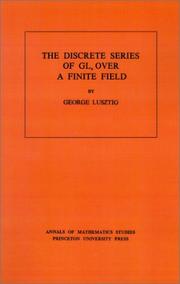
ISBN: 0691081549 1400881765 9780691081540 Year: 1974 Volume: 81 Publisher: Princeton, N.J.
Abstract | Keywords | Export | Availability | Bookmark
 Loading...
Loading...Choose an application
- Reference Manager
- EndNote
- RefWorks (Direct export to RefWorks)
In this book Professor Lusztig solves an interesting problem by entirely new methods: specifically, the use of cohomology of buildings and related complexes.The book gives an explicit construction of one distinguished member, D(V), of the discrete series of GLn (Fq), where V is the n-dimensional F-vector space on which GLn(Fq) acts. This is a p-adic representation; more precisely D(V) is a free module of rank (q--1) (q2-1)...(qn-1-1) over the ring of Witt vectors WF of F. In Chapter 1 the author studies the homology of partially ordered sets, and proves some vanishing theorems for the homology of some partially ordered sets associated to geometric structures. Chapter 2 is a study of the representation △ of the affine group over a finite field. In Chapter 3 D(V) is defined, and its restriction to parabolic subgroups is determined. In Chapter 4 the author computes the character of D(V), and shows how to obtain other members of the discrete series by applying Galois automorphisms to D(V). Applications are in Chapter 5. As one of the main applications of his study the author gives a precise analysis of a Brauer lifting of the standard representation of GLn(Fq).
Group theory --- Algebraic fields --- Linear algebraic groups --- Representations of groups --- Series --- 511.33 --- Algebra --- Mathematics --- Processes, Infinite --- Sequences (Mathematics) --- Group representation (Mathematics) --- Groups, Representation theory of --- Algebraic groups, Linear --- Geometry, Algebraic --- Algebraic varieties --- Algebraic number fields --- Algebraic numbers --- Fields, Algebraic --- Algebra, Abstract --- Algebraic number theory --- Rings (Algebra) --- Analytical and multiplicative number theory. Asymptotics. Sieves etc. --- Algebraic fields. --- Linear algebraic groups. --- Representations of groups. --- Series. --- 511.33 Analytical and multiplicative number theory. Asymptotics. Sieves etc. --- Analytical and multiplicative number theory. Asymptotics. Sieves etc --- Addition. --- Affine group. --- Automorphism. --- Dimension. --- Eigenvalues and eigenvectors. --- Endomorphism. --- Field of fractions. --- Finite field. --- Free module. --- Grothendieck group. --- Homomorphism. --- Linear subspace. --- Morphism. --- P-adic number. --- Partially ordered set. --- Simplicial complex. --- Tensor product. --- Theorem. --- Witt vector. --- Groupes algébriques linéaires --- Groupes algébriques linéaires --- Représentations de groupes
Book
ISBN: 0691080917 1400881781 9780691080918 Year: 1971 Volume: 68 Publisher: Princeton, N.J.
Abstract | Keywords | Export | Availability | Bookmark
 Loading...
Loading...Choose an application
- Reference Manager
- EndNote
- RefWorks (Direct export to RefWorks)
Part exposition and part presentation of new results, this monograph deals with that area of mathematics which has both combinatorial group theory and mathematical logic in common. Its main topics are the word problem for groups, the conjugacy problem for groups, and the isomorphism problem for groups. The presentation depends on previous results of J. L. Britton, which, with other factual background, are treated in detail.
Group theory --- 510.6 --- Mathematical logic --- 510.6 Mathematical logic --- Group theory. --- Logic, Symbolic and mathematical. --- Groupes, Théorie des --- Groups, Theory of --- Substitutions (Mathematics) --- Algebra --- Algebra of logic --- Logic, Universal --- Symbolic and mathematical logic --- Symbolic logic --- Mathematics --- Algebra, Abstract --- Metamathematics --- Set theory --- Syllogism --- Abelian group. --- Betti number. --- Characteristic function (probability theory). --- Characterization (mathematics). --- Combinatorial group theory. --- Conjecture. --- Conjugacy class. --- Conjugacy problem. --- Contradiction. --- Corollary. --- Cyclic permutation. --- Decision problem. --- Diffeomorphism. --- Direct product. --- Direct proof. --- Effective method. --- Elementary class. --- Embedding. --- Enumeration. --- Epimorphism. --- Equation. --- Equivalence relation. --- Exact sequence. --- Existential quantification. --- Finite group. --- Finite set. --- Finitely generated group. --- Finitely presented. --- Free group. --- Free product. --- Fundamental group. --- Fundamental theorem. --- Group (mathematics). --- Gödel numbering. --- Homomorphism. --- Homotopy. --- Inner automorphism. --- Markov property. --- Mathematical logic. --- Mathematical proof. --- Mathematics. --- Monograph. --- Natural number. --- Nilpotent group. --- Normal subgroup. --- Notation. --- Permutation. --- Polycyclic group. --- Presentation of a group. --- Quotient group. --- Recursive set. --- Requirement. --- Residually finite group. --- Semigroup. --- Simple set. --- Simplicial complex. --- Solvable group. --- Statistical hypothesis testing. --- Subgroup. --- Theorem. --- Theory. --- Topology. --- Transitive relation. --- Triviality (mathematics). --- Truth table. --- Turing degree. --- Turing machine. --- Without loss of generality. --- Word problem (mathematics). --- Groupes, Théorie des --- Décidabilité (logique mathématique)
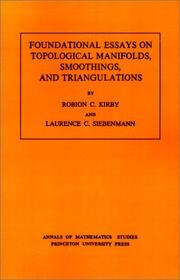
ISBN: 0691081905 0691081913 1400881501 9780691081908 Year: 1977 Volume: no. 88 Publisher: Princeton, N.J.
Abstract | Keywords | Export | Availability | Bookmark
 Loading...
Loading...Choose an application
- Reference Manager
- EndNote
- RefWorks (Direct export to RefWorks)
Since Poincaré's time, topologists have been most concerned with three species of manifold. The most primitive of these--the TOP manifolds--remained rather mysterious until 1968, when Kirby discovered his now famous torus unfurling device. A period of rapid progress with TOP manifolds ensued, including, in 1969, Siebenmann's refutation of the Hauptvermutung and the Triangulation Conjecture. Here is the first connected account of Kirby's and Siebenmann's basic research in this area.The five sections of this book are introduced by three articles by the authors that initially appeared between 1968 and 1970. Appendices provide a full discussion of the classification of homotopy tori, including Casson's unpublished work and a consideration of periodicity in topological surgery.
Differential geometry. Global analysis --- Manifolds (Mathematics) --- Piecewise linear topology --- Triangulating manifolds --- Variétés (Mathématiques) --- Topologie linéaire par morceaux --- 515.16 --- Manifolds, Triangulating --- PL topology --- Topology --- Geometry, Differential --- Topology of manifolds --- Piecewise linear topology. --- Triangulating manifolds. --- Manifolds (Mathematics). --- 515.16 Topology of manifolds --- Variétés (Mathématiques) --- Topologie linéaire par morceaux --- Triangulation. --- Triangulation --- Affine space. --- Algebraic topology (object). --- Approximation. --- Associative property. --- Automorphism. --- Big O notation. --- CW complex. --- Calculation. --- Cap product. --- Cartesian product. --- Category of sets. --- Chain complex. --- Classification theorem. --- Classifying space. --- Cobordism. --- Codimension. --- Cofibration. --- Cohomology. --- Connected space. --- Continuous function (set theory). --- Continuous function. --- Counterexample. --- Diffeomorphism. --- Differentiable manifold. --- Differential structure. --- Differential topology. --- Dimension (vector space). --- Direct proof. --- Disjoint union. --- Elementary proof. --- Embedding. --- Euclidean space. --- Existence theorem. --- Existential quantification. --- Fiber bundle. --- Fibration. --- General position. --- Geometry. --- Group homomorphism. --- H-cobordism. --- H-space. --- Handle decomposition. --- Handlebody. --- Hauptvermutung. --- Hausdorff space. --- Hilbert cube. --- Homeomorphism group. --- Homeomorphism. --- Homomorphism. --- Homotopy group. --- Homotopy. --- Inclusion map. --- Injective function. --- Invertible matrix. --- K-cell (mathematics). --- Kan extension. --- Linear subspace. --- Linear topology. --- Manifold. --- Mapping cylinder. --- Mathematical induction. --- Mathematician. --- Metric space. --- Morse theory. --- Neighbourhood (mathematics). --- Open set. --- Partition of unity. --- Piecewise linear manifold. --- Piecewise linear. --- Poincaré conjecture. --- Polyhedron. --- Principal bundle. --- Product metric. --- Pushout (category theory). --- Regular homotopy. --- Retract. --- Sheaf (mathematics). --- Simplicial complex. --- Smoothing. --- Spin structure. --- Stability theory. --- Stable manifold. --- Standard map. --- Submanifold. --- Submersion (mathematics). --- Subset. --- Surgery exact sequence. --- Surjective function. --- Theorem. --- Topological group. --- Topological manifold. --- Topological space. --- Topology. --- Transversal (geometry). --- Transversality (mathematics). --- Transversality theorem. --- Union (set theory). --- Uniqueness theorem. --- Vector bundle. --- Zorn's lemma. --- Variétés topologiques
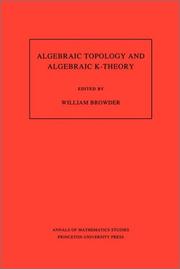
ISBN: 0691084157 0691084262 1400882117 Year: 1987 Publisher: Princeton : Princeton University Press,
Abstract | Keywords | Export | Availability | Bookmark
 Loading...
Loading...Choose an application
- Reference Manager
- EndNote
- RefWorks (Direct export to RefWorks)
This book contains accounts of talks held at a symposium in honorof John C. Moore in October 1983 at Princeton University, The workincludes papers in classical homotopy theory, homological algebra,rational homotopy theory, algebraic K-theory of spaces, and othersubjects.
Algebraic topology --- K-theory --- 512.73 --- 515.14 --- 512.73 Cohomology theory of algebraic varieties and schemes --- Cohomology theory of algebraic varieties and schemes --- 515.14 Algebraic topology --- Moore, John C. --- Abelian group. --- Adams spectral sequence. --- Adjoint functors. --- Adjunction (field theory). --- Algebraic K-theory. --- Algebraic closure. --- Algebraic geometry. --- Algebraic group. --- Algebraic number field. --- Algebraic space. --- Algebraic topology. --- Algebraically closed field. --- Associative algebra. --- Boundary (topology). --- CW complex. --- Classification theorem. --- Closure (mathematics). --- Coalgebra. --- Cofibration. --- Cohomology. --- Commutative diagram. --- Commutative property. --- Coproduct. --- Deformation theory. --- Degenerate bilinear form. --- Diagram (category theory). --- Differentiable manifold. --- Dimension (vector space). --- Division algebra. --- Eilenberg–Moore spectral sequence. --- Epimorphism. --- Exterior (topology). --- Formal power series. --- Free Lie algebra. --- Free algebra. --- Freudenthal suspension theorem. --- Function (mathematics). --- Function space. --- Functor. --- G-module. --- Galois extension. --- Global dimension. --- Group cohomology. --- Group homomorphism. --- H-space. --- Hilbert's Theorem 90. --- Homology (mathematics). --- Homomorphism. --- Homotopy category. --- Homotopy group. --- Homotopy. --- Hopf algebra. --- Hopf invariant. --- Hurewicz theorem. --- Inclusion map. --- Inequality (mathematics). --- Integral domain. --- Isometry. --- Isomorphism class. --- K-theory. --- Lie algebra. --- Lie group. --- Limit (category theory). --- Loop space. --- Mathematician. --- Mathematics. --- Noetherian ring. --- Order topology. --- P-adic number. --- Polynomial ring. --- Polynomial. --- Prime number. --- Principal bundle. --- Principal ideal domain. --- Projective module. --- Projective plane. --- Pullback (category theory). --- Pushout (category theory). --- Ring of integers. --- Series (mathematics). --- Sheaf (mathematics). --- Simplicial category. --- Simplicial complex. --- Simplicial set. --- Special case. --- Spectral sequence. --- Square (algebra). --- Stable homotopy theory. --- Steenrod algebra. --- Superalgebra. --- Theorem. --- Topological K-theory. --- Topological space. --- Topology. --- Triviality (mathematics). --- Uniqueness theorem. --- Universal enveloping algebra. --- Vector bundle. --- Weak equivalence (homotopy theory). --- William Browder (mathematician). --- Géométrie algébrique --- K-théorie
Book
ISBN: 1400881226 9781400881222 9780691161693 9780691161686 0691161682 9780691161686 0691161690 9780691161693 Year: 2016 Publisher: Princeton, NJ
Abstract | Keywords | Export | Availability | Bookmark
 Loading...
Loading...Choose an application
- Reference Manager
- EndNote
- RefWorks (Direct export to RefWorks)
Over the field of real numbers, analytic geometry has long been in deep interaction with algebraic geometry, bringing the latter subject many of its topological insights. In recent decades, model theory has joined this work through the theory of o-minimality, providing finiteness and uniformity statements and new structural tools. For non-archimedean fields, such as the p-adics, the Berkovich analytification provides a connected topology with many thoroughgoing analogies to the real topology on the set of complex points, and it has become an important tool in algebraic dynamics and many other areas of geometry. This book lays down model-theoretic foundations for non-archimedean geometry. The methods combine o-minimality and stability theory. Definable types play a central role, serving first to define the notion of a point and then properties such as definable compactness. Beyond the foundations, the main theorem constructs a deformation retraction from the full non-archimedean space of an algebraic variety to a rational polytope. This generalizes previous results of V. Berkovich, who used resolution of singularities methods. No previous knowledge of non-archimedean geometry is assumed. Model-theoretic prerequisites are reviewed in the first sections.
Tame algebras. --- Algebras, Tame --- Associative algebras --- Abhyankar property. --- Berkovich space. --- Galois orbit. --- Riemann-Roch. --- Zariski dense open set. --- Zariski open subset. --- Zariski topology. --- algebraic geometry. --- algebraic variety. --- algebraically closed valued field. --- analytic geometry. --- birational invariant. --- canonical extension. --- connectedness. --- continuity criteria. --- continuous definable map. --- continuous map. --- curve fibration. --- definable compactness. --- definable function. --- definable homotopy type. --- definable set. --- definable space. --- definable subset. --- definable topological space. --- definable topology. --- definable type. --- definably compact set. --- deformation retraction. --- finite simplicial complex. --- finite-dimensional vector space. --- forward-branching point. --- fundamental space. --- g-continuity. --- g-continuous. --- g-open set. --- germ. --- good metric. --- homotopy equivalence. --- homotopy. --- imaginary base set. --- ind-definable set. --- ind-definable subset. --- inflation homotopy. --- inflation. --- inverse limit. --- iso-definability. --- iso-definable set. --- iso-definable subset. --- iterated place. --- linear topology. --- main theorem. --- model theory. --- morphism. --- natural functor. --- non-archimedean geometry. --- non-archimedean tame topology. --- o-minimal formulation. --- o-minimality. --- orthogonality. --- path. --- pro-definable bijection. --- pro-definable map. --- pro-definable set. --- pro-definable subset. --- pseudo-Galois covering. --- real numbers. --- relatively compact set. --- residue field extension. --- retraction. --- schematic distance. --- semi-lattice. --- sequence. --- smooth case. --- smoothness. --- stability theory. --- stable completion. --- stable domination. --- stably dominated point. --- stably dominated type. --- stably dominated. --- strong stability. --- substructure. --- topological embedding. --- topological space. --- topological structure. --- topology. --- transcendence degree. --- v-continuity. --- valued field. --- Γ-internal set. --- Γ-internal space. --- Γ-internal subset.
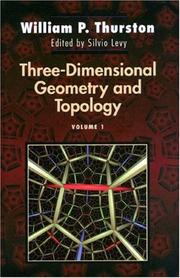
ISBN: 0691083045 1400865328 9780691083049 Year: 1997 Volume: 35. Publisher: Princeton, N.J. Princeton University
Abstract | Keywords | Export | Availability | Bookmark
 Loading...
Loading...Choose an application
- Reference Manager
- EndNote
- RefWorks (Direct export to RefWorks)
This book develops some of the extraordinary richness, beauty, and power of geometry in two and three dimensions, and the strong connection of geometry with topology. Hyperbolic geometry is the star. A strong effort has been made to convey not just denatured formal reasoning (definitions, theorems, and proofs), but a living feeling for the subject. There are many figures, examples, and exercises of varying difficulty.
Topology --- Differential geometry. Global analysis --- Geometry, Hyperbolic --- Three-manifolds (Topology) --- Géométrie hyperbolique --- Variétés topologiques à 3 dimensions --- Geometry, Hyperbolic. --- 514.1 --- 3-manifolds (Topology) --- Manifolds, Three dimensional (Topology) --- Three-dimensional manifolds (Topology) --- Low-dimensional topology --- Topological manifolds --- Hyperbolic geometry --- Lobachevski geometry --- Lobatschevski geometry --- Geometry, Non-Euclidean --- General geometry --- Three-manifolds (Topology). --- 514.1 General geometry --- Géométrie hyperbolique --- Variétés topologiques à 3 dimensions --- 3-sphere. --- Abelian group. --- Affine space. --- Affine transformation. --- Atlas (topology). --- Automorphism. --- Basis (linear algebra). --- Bounded set (topological vector space). --- Brouwer fixed-point theorem. --- Cartesian coordinate system. --- Characterization (mathematics). --- Compactification (mathematics). --- Conformal map. --- Contact geometry. --- Curvature. --- Cut locus (Riemannian manifold). --- Diagram (category theory). --- Diffeomorphism. --- Differentiable manifold. --- Dimension (vector space). --- Dimension. --- Disk (mathematics). --- Divisor (algebraic geometry). --- Dodecahedron. --- Eigenvalues and eigenvectors. --- Embedding. --- Euclidean space. --- Euler number. --- Exterior (topology). --- Facet (geometry). --- Fiber bundle. --- Foliation. --- Fundamental group. --- Gaussian curvature. --- Geometry. --- Group homomorphism. --- Half-space (geometry). --- Holonomy. --- Homeomorphism. --- Homotopy. --- Horocycle. --- Hyperbolic geometry. --- Hyperbolic manifold. --- Hyperbolic space. --- Hyperboloid model. --- Interior (topology). --- Intersection (set theory). --- Isometry group. --- Isometry. --- Jordan curve theorem. --- Lefschetz fixed-point theorem. --- Lie algebra. --- Lie group. --- Line (geometry). --- Linear map. --- Linearization. --- Manifold. --- Mathematical induction. --- Metric space. --- Moduli space. --- Möbius transformation. --- Norm (mathematics). --- Pair of pants (mathematics). --- Piecewise linear manifold. --- Piecewise linear. --- Poincaré disk model. --- Polyhedron. --- Projection (linear algebra). --- Projection (mathematics). --- Pseudogroup. --- Pullback (category theory). --- Quasi-isometry. --- Quotient space (topology). --- Riemann mapping theorem. --- Riemann surface. --- Riemannian manifold. --- Sheaf (mathematics). --- Sign (mathematics). --- Simplicial complex. --- Simply connected space. --- Special linear group. --- Stokes' theorem. --- Subgroup. --- Subset. --- Tangent space. --- Tangent vector. --- Tetrahedron. --- Theorem. --- Three-dimensional space (mathematics). --- Topological group. --- Topological manifold. --- Topological space. --- Topology. --- Transversal (geometry). --- Two-dimensional space. --- Uniformization theorem. --- Unit sphere. --- Variable (mathematics). --- Vector bundle. --- Vector field. --- Topologie algébrique --- Topologie combinatoire --- Algebraic topology. --- Combinatorial topology. --- Variétés topologiques --- Geometrie --- Theorie des noeuds
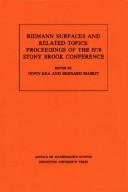
ISBN: 0691082642 0691082677 1400881552 Year: 1981 Publisher: Princeton, N.J.
Abstract | Keywords | Export | Availability | Bookmark
 Loading...
Loading...Choose an application
- Reference Manager
- EndNote
- RefWorks (Direct export to RefWorks)
The description for this book, Riemann Surfaces Related Topics (AM-97), Volume 97: Proceedings of the 1978 Stony Brook Conference. (AM-97), will be forthcoming.
Geometry --- Riemann surfaces --- -517.54 --- Surfaces, Riemann --- Functions --- Congresses --- Conformal mapping and geometric problems in the theory of functions of a complex variable. Analytic functions and their generalizations --- 517.54 Conformal mapping and geometric problems in the theory of functions of a complex variable. Analytic functions and their generalizations --- 517.54 --- Riemann, Surfaces de --- Abstract simplicial complex. --- Affine transformation. --- Algebraic curve. --- Algebraic element. --- Algebraic equation. --- Algebraic surface. --- Analytic function. --- Analytic torsion. --- Automorphic form. --- Automorphic function. --- Automorphism. --- Banach space. --- Basis (linear algebra). --- Boundary (topology). --- Bounded set (topological vector space). --- Cohomology ring. --- Cohomology. --- Commutative property. --- Commutator subgroup. --- Compact Riemann surface. --- Complex analysis. --- Complex manifold. --- Conformal geometry. --- Conformal map. --- Conjugacy class. --- Covering space. --- Diagram (category theory). --- Dimension (vector space). --- Divisor (algebraic geometry). --- Divisor. --- Eigenvalues and eigenvectors. --- Equivalence class. --- Equivalence relation. --- Ergodic theory. --- Existential quantification. --- Foliation. --- Fuchsian group. --- Fundamental domain. --- Fundamental group. --- Fundamental polygon. --- Geodesic. --- Geometric function theory. --- Group homomorphism. --- H-cobordism. --- Hausdorff measure. --- Holomorphic function. --- Homeomorphism. --- Homomorphism. --- Homotopy. --- Hyperbolic 3-manifold. --- Hyperbolic manifold. --- Hyperbolic space. --- Infimum and supremum. --- Injective module. --- Interior (topology). --- Intersection form (4-manifold). --- Isometry. --- Isomorphism class. --- Jordan curve theorem. --- Kleinian group. --- Kähler manifold. --- Limit point. --- Limit set. --- Manifold. --- Meromorphic function. --- Metric space. --- Mostow rigidity theorem. --- Möbius transformation. --- Poincaré conjecture. --- Pole (complex analysis). --- Polynomial. --- Product topology. --- Projective variety. --- Quadratic differential. --- Quasi-isometry. --- Quasiconformal mapping. --- Quotient space (topology). --- Radon–Nikodym theorem. --- Ricci curvature. --- Riemann mapping theorem. --- Riemann sphere. --- Riemann surface. --- Riemannian geometry. --- Riemannian manifold. --- Schwarzian derivative. --- Strictly convex space. --- Subgroup. --- Submanifold. --- Surjective function. --- Tangent space. --- Teichmüller space. --- Theorem. --- Topological conjugacy. --- Topological space. --- Topology. --- Uniformization theorem. --- Uniformization. --- Uniqueness theorem. --- Unit disk. --- Vector bundle.
Book
ISBN: 1400874017 Year: 2015 Publisher: Princeton : Princeton University Press,
Abstract | Keywords | Export | Availability | Bookmark
 Loading...
Loading...Choose an application
- Reference Manager
- EndNote
- RefWorks (Direct export to RefWorks)
Descent in Buildings begins with the resolution of a major open question about the local structure of Bruhat-Tits buildings. The authors then put their algebraic solution into a geometric context by developing a general fixed point theory for groups acting on buildings of arbitrary type, giving necessary and sufficient conditions for the residues fixed by a group to form a kind of subbuilding or "form" of the original building. At the center of this theory is the notion of a Tits index, a combinatorial version of the notion of an index in the relative theory of algebraic groups. These results are combined at the end to show that every exceptional Bruhat-Tits building arises as a form of a "residually pseudo-split" Bruhat-Tits building. The book concludes with a display of the Tits indices associated with each of these exceptional forms.This is the third and final volume of a trilogy that began with Richard Weiss' The Structure of Spherical Buildings and The Structure of Affine Buildings.
Buildings (Group theory) --- Combinatorial geometry. --- Geometric combinatorics --- Geometrical combinatorics --- Combinatorial analysis --- Discrete geometry --- Theory of buildings (Group theory) --- Tits's theory of buildings (Group theory) --- Linear algebraic groups --- Bruhat-Tits building. --- Clifford invariant. --- Coxeter diagram. --- Coxeter group. --- Coxeter system. --- Euclidean plane. --- Fundamental Theorem of Descent. --- Moufang building. --- Moufang condition. --- Moufang polygon. --- Moufang quadrangle. --- Moufang set. --- Moufang structure. --- Pfister form. --- Structure Theorem. --- Tits index. --- abelian group. --- absolute Coxeter diagram. --- absolute Coxeter system. --- absolute rank. --- affine building. --- algebraic group. --- anisotropic pseudo-quadratic space. --- anisotropic quadratic space. --- anti-isomorphism. --- apartment. --- arctic region. --- automorphism. --- bilinear form. --- biquaternion division algebra. --- building. --- canonical isomorphism. --- chamber. --- compatible representation. --- descent group. --- descent. --- discrete valuation. --- exceptional Moufang quadrangle. --- exceptional quadrangle. --- finite dimension. --- fixed point building. --- fixed point theory. --- gem. --- generalized quadrangle. --- hyperbolic plane. --- hyperbolic quadratic module. --- hyperbolic quadratic space. --- involutory set. --- isomorphism. --- isotropic quadratic space. --- length function. --- non-abelian group. --- parallel residues. --- polar space. --- projection map. --- proper indifferent set. --- proper involutory set. --- pseudo-quadratic space. --- pseudo-split building. --- quadratic form. --- quadratic module. --- quadratic space. --- quaternion division algebra. --- ramified quadrangle. --- ramified quaternion division algebra. --- ramified separable quadratic extension. --- relative Coxeter diagram. --- relative Coxeter group. --- relative Coxeter system. --- relative rank. --- residual quadratic spaces. --- residue. --- root group sequence. --- root. --- round quadratic space. --- scalar multiplication. --- semi-ramified quadrangle. --- separable quadratic extension. --- simplicial complex. --- special vertex. --- spherical building. --- split quadratic space. --- standard involution. --- subbuilding of split type. --- subbuilding. --- tamely ramified division algebra. --- thick building. --- thin T-building. --- trace map. --- trace. --- unramified quadrangle. --- unramified quadratic space. --- unramified quaternion division algebra. --- unramified separable quadratic extension. --- vector space. --- vertex. --- weak isomorphism. --- wild quadratic space.
| Listing 1 - 8 of 8 |
Sort by
|

 Search
Search Feedback
Feedback About UniCat
About UniCat  Help
Help News
News